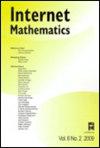A Multi-type Preferential Attachment Tree
Q3 Mathematics
引用次数: 9
Abstract
A multi-type preferential attachment tree is introduced, and studied using general multi-type branching processes. For the $p$-type case we derive a framework for studying the tree where a type $i$ vertex generates new type $j$ vertices with rate $w_{ij}(n_1,n_2,\ldots, n_p)$ where $n_k$ is the number of type $k$ vertices previously generated by the type $i$ vertex, and $w_{ij}$ is a non-negative function from $\mathbb{N}^p$ to $\mathbb{R}$. The framework is then used to derive results for trees with more specific attachment rates. In the case with linear preferential attachment---where type $i$ vertices generate new type $j$ vertices with rate $w_{ij}(n_1,n_2,\ldots, n_p)=\gamma_{ij}(n_1+n_2+\dots +n_p)+\beta_{ij}$, where $\gamma_{ij}$ and $\beta_{ij}$ are positive constants---we show that under mild regularity conditions on the parameters $\{\gamma_{ij}\}, \{\beta_{ij}\}$ the asymptotic degree distribution of a vertex is a power law distribution. The asymptotic composition of the vertex population is also studied.多类型优先依恋树
介绍了一种多类型优先连接树,并利用一般的多类型分支过程进行了研究。对于$p$类型的情况,我们导出了一个研究树的框架,其中类型$i$顶点生成新的类型$j$顶点,速率为$w_{ij}(n_1,n2,\ldots,n_p)$,其中$n_k$是以前由类型$i$顶点生成的类型$k$顶点的数量,$w_{ij}$是从$\mathbb{n}^p$到$\mathbb{R}$的非负函数。然后使用该框架来导出具有更具体附着率的树的结果。在线性优先附着的情况下——其中类型$i$顶点生成新类型$j$顶点,速率为$w_,顶点的渐近度分布是幂律分布。还研究了顶点总体的渐近组成。
本文章由计算机程序翻译,如有差异,请以英文原文为准。
求助全文
约1分钟内获得全文
求助全文

 求助内容:
求助内容: 应助结果提醒方式:
应助结果提醒方式:


